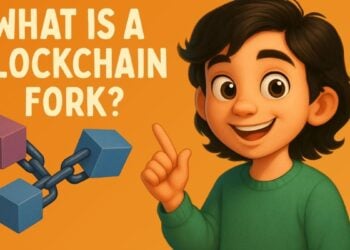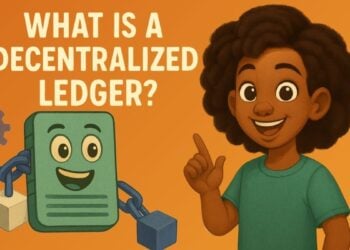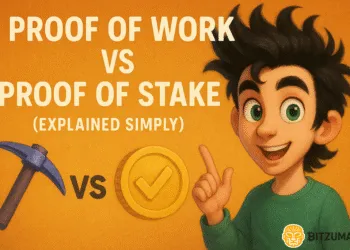In just over a decade, blockchain has gone from a niche concept powering Bitcoin to one of the most disruptive technologies of the 21st century. But despite the hype, many people still ask the same question:
“What exactly is blockchain — and why does it matter?”
At its core, blockchain is a way to record and share information across a network, without needing a central authority to manage or verify it. It’s like a digital ledger — but one that is transparent, decentralized, and tamper-proof.
Originally created to support cryptocurrencies, blockchain technology now powers everything from finance and supply chains to identity systems and digital art.
In this guide, we’ll break it down simply — so you can finally understand what blockchain really is, how it works, and why it’s changing the way we think about trust, data, and ownership.
New to crypto? Start here: What Is a Cryptocurrency? A Beginner’s Introduction
What Is a Blockchain?
Imagine a notebook that anyone in the world can access, where each new page added is instantly visible to everyone — and once written, nothing can ever be erased or changed.
That’s the essence of a blockchain: a digital, distributed ledger that records data across a network of computers. Each entry is grouped into a “block,” and every block is linked to the one before it — forming a continuous, unbreakable chain.
What makes blockchain so revolutionary isn’t just how it stores data, but how it secures and shares it. Instead of relying on a central entity (like a bank or a tech company) to manage or verify information, a blockchain uses a decentralized network where everyone holds a copy — and updates happen only when the network agrees.
This means that:
- No single party controls the system
- Data is resistant to censorship and tampering
- Anyone can verify what’s true by checking the chain itself
Originally invented to support Bitcoin, the first cryptocurrency, blockchain technology has since evolved far beyond digital money — becoming the foundation for an entire new class of internet applications.
Did You Know? The word “blockchain” was never actually used in the original Bitcoin whitepaper — it just referred to a “chain of blocks.” The term came later as developers began to describe the system more casually.
How Does Blockchain Work?
To understand how blockchain works, let’s go back to the “digital notebook” analogy. Each time someone wants to record a new transaction — whether it’s sending crypto, registering a vote, or storing a document — that information is written onto a new page, or block.
But here’s what makes it different from any regular database:
Before a block is added, the network must first agree that the information inside it is valid. This process is called consensus — and it ensures that no one can cheat or rewrite the history of transactions. Depending on the blockchain, this can be achieved through mechanisms like Proof of Work or Proof of Stake, which we’ll explore in another article.
Once validated, the block is added to the chain — permanently. Every block contains three main elements:
- The data (like transactions)
- A timestamp
- A cryptographic hash of the previous block
That last part — the hash — is what links the blocks together in chronological order. If even a single number in the block changes, its hash changes too, breaking the chain and alerting the entire network.
This combination of cryptographic security, network consensus, and linked records is what gives blockchain its unique power: a public system where data is transparent, verifiable, and virtually impossible to alter.
Why Blockchain Is Unique
Blockchain isn’t just a different way of storing data — it’s a fundamentally different way of building trust.
In traditional systems, we rely on intermediaries: banks to verify our money, companies to protect our data, governments to keep records. But these systems can be slow, expensive, or even corruptible.
Blockchain replaces that reliance with something radically new: math, code, and collective agreement.
Because every transaction is recorded on a public ledger, visible to all, there’s no need to “trust” a middleman — you can simply verify the data yourself. That’s what people mean when they call blockchain “trustless”: not because it lacks trust, but because it removes the need for blind trust.
Real-World Analogy: A blockchain works more like a shared Google Doc than a Word file. Everyone can see the changes in real time, and no one can edit past versions without everyone knowing.
This makes blockchain:
- Transparent: anyone can audit the data
- Decentralized: no single point of control or failure
- Immutable: once something is recorded, it can’t be changed without rewriting the entire chain — which is practically impossible
These properties are exactly why blockchain has become the backbone of crypto — and why industries beyond finance are starting to adopt it.
Where Is Blockchain Used Today?
While blockchain was originally created to power Bitcoin, its use cases today go far beyond cryptocurrency.
In finance, blockchain is the foundation of decentralized applications — platforms where people can borrow, lend, and trade without banks. Stablecoins, NFTs, and cross-border payments all run on blockchains like Ethereum and Solana.
In supply chains, companies like IBM and Walmart use blockchain to track products from source to shelf. This helps fight fraud, improve transparency, and ensure safety — for example, tracing the origin of food or medicine.
In healthcare, it’s used to securely store medical records and give patients more control over their data. In voting, blockchain can make election systems more secure and verifiable.
Even digital identity systems are being built on blockchain, letting people prove who they are without handing over their personal data to centralized platforms.
In short, anywhere trust, transparency, and record-keeping matter — blockchain can be a game changer.
Fun Fact: The United Nations and World Food Programme have already used blockchain to distribute food aid to refugees — helping prevent fraud and improve transparency in crisis zones.
Blockchain FAQs
What is blockchain in simple words?
A blockchain is a public digital ledger where information is recorded in blocks, linked in order, and secured by cryptography. It’s transparent, decentralized, and almost impossible to alter once written.
Is blockchain only used for cryptocurrencies?
No. While it was first created for Bitcoin, blockchain is now used in finance, healthcare, logistics, voting, identity systems, and much more — anywhere secure, tamper-proof records are needed.
Who controls a blockchain?
In public blockchains like Bitcoin or Ethereum, no single person or company controls the network. Instead, thousands of independent nodes verify transactions and maintain the ledger through consensus.
Can a blockchain be hacked?
It’s extremely difficult. To alter a blockchain, you’d need to take over more than 50% of the network — which is nearly impossible on large, well-secured blockchains. However, apps built on top of blockchains (like wallets or smart contracts) can still be vulnerable.
What’s the difference between a blockchain and a traditional database?
Traditional databases are centralized — managed by one authority — and can be edited. Blockchains are distributed, immutable, and rely on network-wide consensus to update records.
Final Thoughts: Why Blockchain Technology Matters
Blockchain is a new foundation for trust in the digital age.
By removing the need for central authorities and enabling data to be shared securely, transparently, and immutably, blockchain is transforming the way we think about everything from money to identity, from supply chains to online voting.
We’re still in the early stages, but the technology is maturing fast — and its impact is already visible across industries. Whether you’re exploring crypto, building apps, or simply curious about what’s next, understanding blockchain is a crucial first step.
In a world full of middlemen, blockchain gives you back control.
Ready to dive deeper?
















